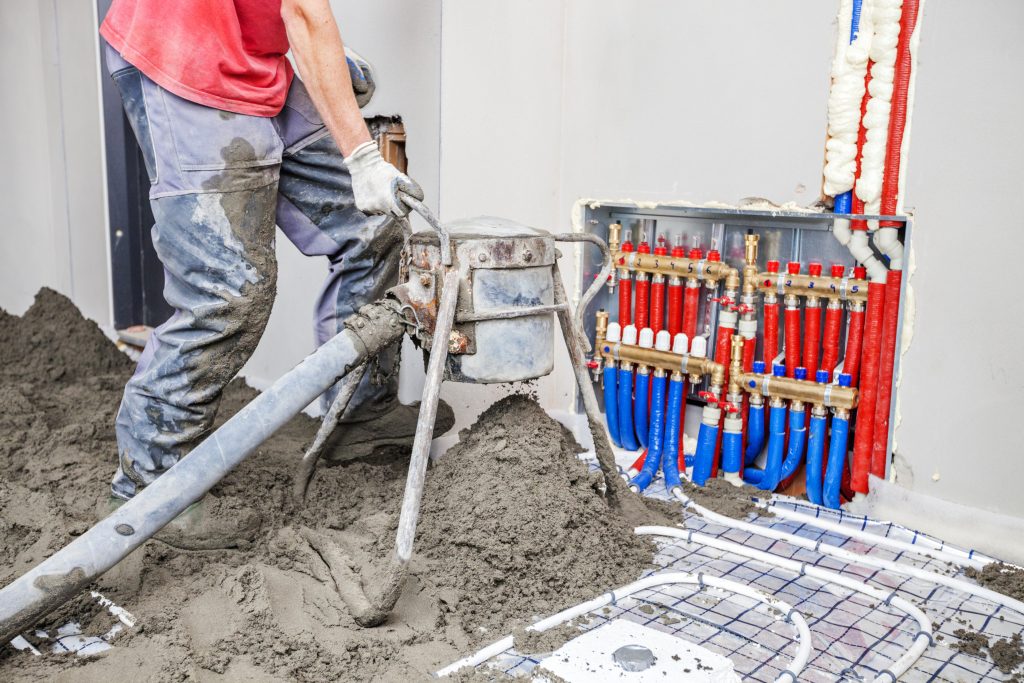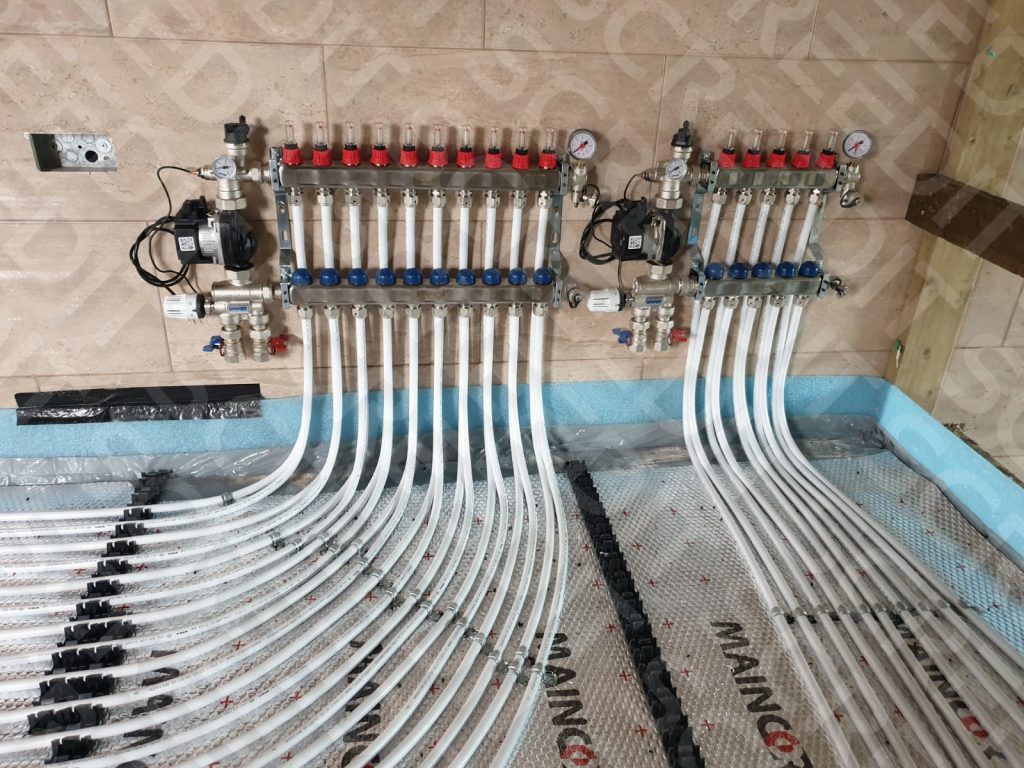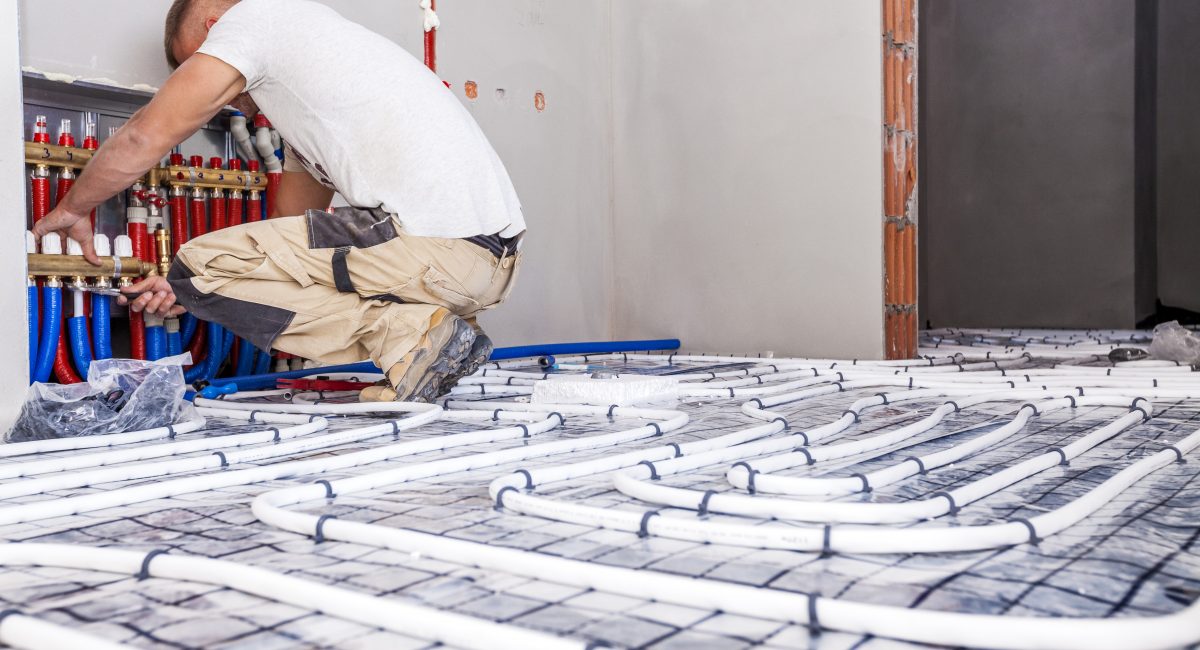Underfloor Heating vs Radiators: Which One is Best for a Project?
When deciding on requirements for a building project, such as heating, you may experience the dilemma of deciding between underfloor heating and radiators. Both do offer their advantages and long term benefits. However, to help settle the question of underfloor heating vs radiators for your work, we’ve created this guide. Here, you will be able to read more about what is better in different circumstances and see comparisons of running and installation costs and energy efficiency.
Read on to learn more, or contact us today if you would like to hear more about the benefits of underfloor heating from our knowledgeable and experienced team.
Is Underfloor Heating Better than Radiators?

Under some circumstances, underfloor heating (UFH) systems may be better than radiator systems. To decide whether or not this is the case in terms of your project, there are a few questions and considerations that you will have to take into account. These include:
- How energy efficient do you need your heating to be?
- Which is more expensive to install?
- Which is more expensive to run in the long term?
- Which is safer?
- Which is more likely to be repaired easily in the event of a breakdown?
- Which is easier to install?
Underfloor Heating vs Radiators: Installation Cost
The first point of consideration is how much both will cost to be installed.
In most cases, UFH systems will be more expensive to install than radiators and come at a higher purchasing cost. This is in part because they will usually require more parts and the installation process itself is likely to be longer. If you’re planning on fitting underfloor heating as part of a renovation project, meaning the system is a “retrofit”, this is also likely to have an impact on the price because the work will be more labour-intensive.
Overall, this gives an immediate advantage to radiators, which usually require fewer parts and can often simply be upgraded or moved during renovation work. This makes them an excellent choice if you are working on a limited budget.
However, the costs involved with installing UFH systems are often later offset by the savings they provide. To learn more about this, please take a look at the information we’ve provided on underfloor heating costs. This advice covers both installation costs and running costs.
Underfloor Heating vs Radiators: Installation Efficiency

When considering how easy and efficient it will be to install either a set of radiators or underfloor heating, you are also likely to find that the circumstances of your project play a role. If you are intending to replace radiator units with the same or a similar model in a renovation project, then the work shouldn’t take more than a few hours for a specialist to complete.
On the other hand, if you are working on a new build or fitting entirely new and different radiator models (for instance, a vertical model instead of a conventional horizontal one) you may need extra time to plan where they will be placed. An entire room or more may have to be reworked around the position of a radiator to ensure the heat output is efficient enough.
Similarly, the ease of installing an underfloor heating system will depend on the type of project you are working on. Naturally, it is more straightforward to install a UFH system as part of a new build or completely new extension, as it can be laid before a screed level or when the final flooring is put down. Installing underfloor heating as a retrofit in a renovation project is more difficult than this, as you will most likely have to dig up the floor.
An electric underfloor heating system may be easier to install than a wet system in either case, as you will need to allow room for the pipework to be installed without too great a height build-up. There are slim systems available for retrofit work that can help to mitigate this, though.
Underfloor Heating vs Radiators: Efficiency at Heating a Home

In terms of heating your home, underfloor heating systems are regularly reported as offering greater levels of efficiency. As the system heats the room from the floor up, it will give an even heating profile and prevent cold spots far more effectively than having radiators installed. As UFH is also controlled by thermostats in different rooms or “zones”, you can also set each one to your preferred temperature and keep every part of your property as warm as you like.
Meanwhile, radiators are normally all part of one central heating system that is controlled by a single thermostat and thermostatic radiator valves (TRVs). These adjust the amount of hot water that enters specific radiators but is less efficient and convenient than adjusting a thermostat. As they are fixed to one location, the room is also likely to feel colder than one that is being heated evenly.
Underfloor Heating vs Radiators: Energy Efficiency
The one fact that most people are aware of about underfloor heating is that it is better than having radiators when it comes to energy efficiency. UFH systems, especially wet systems, work at a lower flow temperature than radiators, meaning that they can run from an existing boiler.
Pairing underfloor heating with heat pumps, which also work most efficiently at lower temperatures, raises the levels of efficiency even more. Most radiators are compatible with standard boilers but are not recommended for heat pumps because of the higher water temperatures they require.
This helps to make it more green and efficient to heat your home using underfloor heating, but further savings are made by the fact that UFH spreads out over and heats a large surface area. The distribution of heat means that objects in a room will be heated directly and a room’s natural humidity will be maintained, keeping the spread even. Conventional radiators, on the other hand, will warm one area and then take time to circulate so that the temperature in the room reaches the desired level. This often leads to owners turning them up to reap the same benefits as they would with UFH, increasing the amount of energy used.
It is important to bear in mind that achieving energy-efficient heating is only truly possible if a property has a good thermal performance. If a property isn’t insulated or is poorly insulated, the heat generated will not be trapped and allowed to circulate. This can often cost homeowners money, as their energy bills will not be reduced.
Bearing all of this in mind, you should see that most energy efficiency and savings can be achieved by using a wet underfloor heating system and having a well-insulated home.
Underfloor Heating vs Radiators: Overall Practicality

One factor is how practical having radiators is against how practical it would be to have underfloor heating installed. This can be split into several different considerations:
- How safe both are
- How much room each provides or takes up
- The lifespan of both systems
- The repairability of both systems
In terms of safety, underfloor heating systems will always beat conventional radiators. They provide the warmth and comfort required but as you can’t touch their surfaces, it isn’t possible to be scalded by them. There are also no exposed sharp edges or pipes that people could catch themselves on.
As nothing is exposed with UFH, you should also find that you have a higher amount of space to furnish and decorate. Radiators, on the other hand, take up wall space and reduce the options that you have for choosing the room design that you want.
The issues of lifespan and maintenance may be one of the most relevant deciding factors in determining what system is better for your project. Depending on the model, radiators may have a lifespan of anywhere between 8 and 15+ years, though frequent use will result in these wearing down over time and requiring maintenance. Flushing them regularly can help to prevent rust and other substances from building up, which may extend their lifespan.
The pipework of a wet underfloor heating system will also require flushing and regular servicing but should last for around 50 years if kept in its best condition. We should note, however, that as regular radiators are more common, it is more likely that professionals will have seen and know what to do if one breaks down. They are also easier to fix, as they are exposed and accessible. You will need to ensure that you get a specialist who knows how to take care of UFH if you choose this as your heating system.
Underfloor Heating vs Radiators: Running Costs
As underfloor heating is more eco-friendly and energy efficient than radiators, and will not have to be turned up as high for a person to feel the benefits, they also offer a homeowner better running costs. They’re particularly effective in doing this for homes that have already been built to be green (or in new builds that are going to be green once fully built) but can also offer savings in properties that have not been designed with this in mind. As long as the system is installed properly it may be up to 25% more efficient than a standard radiator, or even 40% more efficient when installed with a heat pump.
Can Underfloor Heating Replace Radiators?

Underfloor heating systems can replace radiators in a home. Depending on the size of a property and the amount of heat lost from certain rooms and areas, it may even be possible for UFH systems to replace radiator systems throughout an entire property. If you would prefer not to do this, you can also choose to install underfloor heating in part of your property, such as the downstairs area or a new extension, and heat the upstairs with conventional radiators.
To decide whether or not it would be economical and beneficial for your property to have some of its radiators replaced with underfloor heating, consider the points we have listed above. To decide whether or not all of them can be replaced with underfloor heating, you will then need to conduct a heat loss calculation on top of this.
Heat loss calculations tell you whether the heat output of a UFH system meets the heating requirement of any one particular room or area. To know whether or not your room is heated sufficiently, you will have to see if the maximum heat output from the system is greater than the amount of heat lost.
If the amount of heat generated by a UFH system is greater than the amount of heat lost, you should be able to comfortably replace a property’s radiators.

Contacting a Professional Underfloor Heating Contractor
If you have been considering a screed floor for a planned work project and believe that the result will also benefit from having an underfloor heating system fitted, contact Screed It today. We pride ourselves on our expertise and ability to install the wet underfloor heating that our customers need, and we can ensure that yours is installed exactly as you require. We are also ready to carry the work out anywhere in the UK, so you are always guaranteed to be within reach of our services.
One of our team will be waiting to discuss the terms and specifications of your project as soon as you get in touch. With our help, you’ll be able to make the best decision for the flooring of your project, so that you can move ahead with placing an order for the screed and underfloor heating installation that meets the needs of your project.

